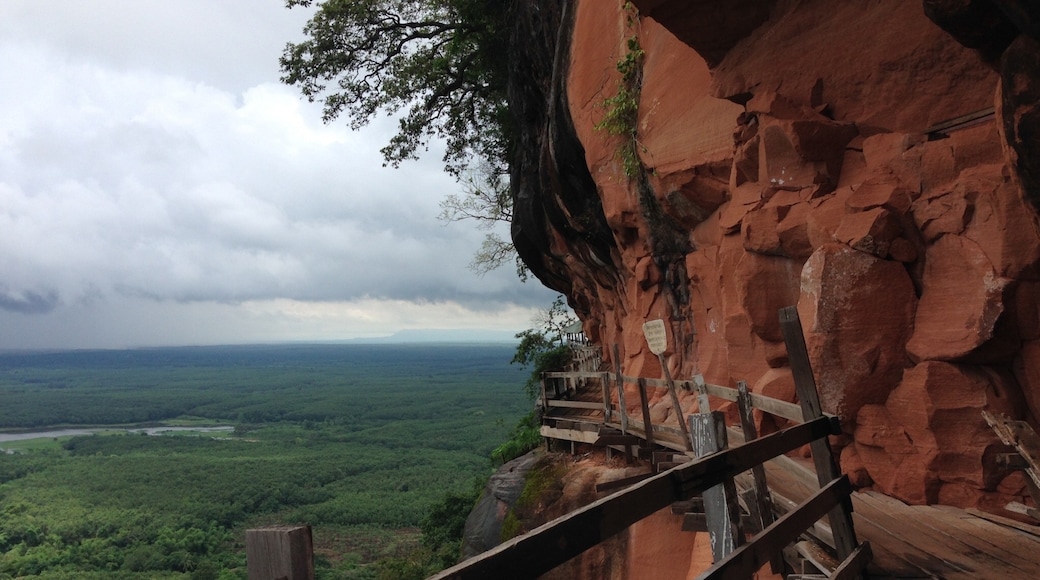
This poost continues to provide information on additional Provinces added to North East Times.
Straddling the Mekong River in a distant corner of Northeast Thailand,Bueng Kan has quietly established itself a fantastic alternative destination for adventure-minded travellers. Bueng Kan province covers a far-flung corner of Isaan (Northeast Thailand) along the Mekong River, with Nong Khai province bordering it to the west (Bueng Kan was part of Nong Khai province before it became a full-blown province on its own) and Nakhon Phanom to the east. To the north lies the remote Bolikhamxay province in Laos.
Established in 2011 as Thailand’s 76th province (or 77th if you include the special administrative area of Bangkok), Bueng Kan remains a rural backwater with riverside villages in view of paddies and jungle-cloaked sandstone plateaus. The scenery captivates many travellers, but a handful of thrilling attractions in the countryside are the big draws for most.
The provincial capital of Bueng Kan lies between the Mekong River and Highway 212, which more-or-less follows the path of the Mekong all the way from Nong Khai to Mukdahan. If doing a road trip, we suggest diverging to the rural back roads that run closest to the river, where the scenery is exceptional in Bung Khla, Ban Ahong and many of the villages scattered in between.
Bueng Kan town—and we definitely consider it a town, not a city—is composed of mostly one- to three-storey buildings in a three square-km grid that extends south from a lengthy riverfront walkway. It’s a typical Isaan town with a fresh market, a few hotels and plenty of som tam and grilled meats, but it lacks tourist attractions apart from some creative street art.
A clock tower stands as a handy reference point within a traffic circle at the centre of Bueng Kan town on Thai Sammakhi Rd. The older part of town extends towards the Mekong in a grid of narrow lanes north of the clock tower, while the newer area hosts Highway 212 to the south. Along the river lies a three-km walkway and a riverfront road with several restaurants. On the east side of town, the Bueng Sawan Reservoir can also be fun for a jog or a bike ride.
A couple of attractions worthy of a visit are:
Tham Phra Waterfall enormous and mesmerizing
Tourist attractions of Bueng Kan Province, many people would think of Phu Thok most of the time.
But today we will take you to see another one of the attractions of Bueng Kan Province that many people have never known before. That is Tham Phra Waterfall, a land of beauty created by nature.

Tham Phra Waterfall or Tham Phra Phu Wua Waterfall It is located in Phu Wua Wildlife Sanctuary, Seka District, Bueng Kan Province. It is a large 3-tiered waterfall that flows on a large sandstone mountain. It is a recreational attraction for tourists who come to see the beauty of the waterfall. There is also a large puddle and a canal where you can play as a slide. You can enjoy swimming in the stream, but the waterfall is full of water only during the rainy season from July to early October. If coming during other months, the water is quite low.
Wat Phu Tok the stunning view on the top

Wat Phu Thok is located in Na Sabang Subdistrict, Si Wilai District, Bueng Kan Province, in the northeast of Thailand, about 10 hours and 30 minutes (751 kilometers) from Bangkok.
Wat Phu Thok is one of the most popular tourist attractions in Bueng Kan Province and is a meditation retreat with beautiful views surrounded by nature. The highlight of Phu Thok is the wooden stairs and wooden bridge to enjoy the breathtaking 360 degree views. There are a total of 7 floors, taking up to 5 years of construction without using any mechanical equipment. All due to the skill of human labor.
Phu Thok consists of two large red-brown sandstone mountains in a row, “Phu Thok Yai” and “Phu Thok Noi”, surrounded by dense forests rich in wildlife.
Hell-Heaven Bridge
“Hell-Sawan Bridge” is a wooden bridge circling from the foothills to the top of Phu Thok Noi at 350 meters above sea level (compared to a 60-70-storey building).
Phra Arjarn Juan, the pioneer of construction, hoped that the bridge would convey the meaning of walking along the Dharma path that could lead the faithful to escape from all suffering.
There are 7 floors
Level 1-2 is a wooden staircase, when entering the 3rd floor up to the 5th floor, there will be a circular bridge around the mountain. The walking path around the third level has rocks, stone terraces, cliffs and trees spreading branches to provide shade.
(Source: – Thailand Travel Information/Travel Fish










